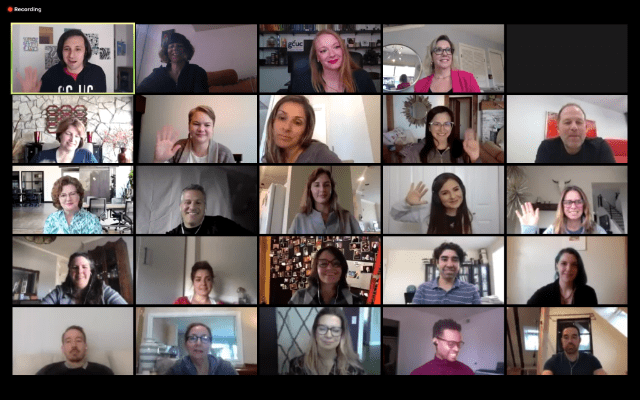The growth of the virtual networks
The outbreak has pushed coworking spaces putting its regular activities and operations on hold while the world adapts to physical distance and prevention measures. To put the coronavirus at bay, we have stayed at home for almost three months, and people have quickly learnt how to keep connected both socially and professionally with family, friends, colleagues, workmates, collaborators and members of our coworking community thanks to the technology. Despite physical distancing measures, social experiences have continued anyway, and virtual networks or online communities have grown and strengthened connections.
I’ve read an article from Cat Johson, an American content strategist focussed on coworking and community, where she presented three possible situations after the lockdown that coworking operators experienced. Each case depends on the community level:
- Little or Nothing
We talk about business centres, those operators focussing just on the rental space and service. Space managers don’t organize activities for members and don’t try to connect them. In this case, the members, after the outbreak, may or may not come back, but their decision will be mostly transactional. It will depend on each business economic situation: a place to work in exchange for payment. - The Middle-Ground
These operators focus on hospitality and have a small core group of people who contribute to and benefit from the community and appreciate the vision, purpose and potential for the workspace. Core members have retained their memberships even though the outbreak. Some of this kind of operators have created virtual coworking offerings and have found online ways to keep their core community connected and supported. They have organized different online activities and have engaged with them. - All-in On Community
In this case, coworking spaces that focus on the community. Usually, they target entrepreneurs, freelancers and startups; and they program daily activities to socialize and promote the sharing culture; we talk about traditional coworking. They have retained members, freezing memberships or proposing memberships based on exchange. They have brought their regular activities to the online and give them any other support. They have leaned into the strength of the community because members relationships are strong and they feel attached to the coworking space.
When talking about members retention during the health crisis in the three situations explained above, we also have to consider other important strategies and factors such as leasing conditions, discounts strategy, the business cash flow are a few of them. In my opinion, from our experience developing coworking spaces, community matters but is not all about it.
How to take your community online?

Some coworking owners have always said that the physical space doesn’t matter, that communities can move, and will move, with you. I fully agree with this theory; in the end, a community is made by people that share the same interests. A good example is Ouishare, a global network of freelancers, entrepreneurs, and thought leaders that question and experiment with social models based on collaboration, openness, and fairness. Or Sin Oficina, a Spanish online coworking with a community of digital professionals.
In any case, this theory is being put to the test during the health crisis as coworking spaces had to take their communities online and isn’t that easy as it seems.
Do you have a vibrant community?
First, before taking your community online, wonder yourself, how is your community, if it is weak, work to strengthen it. Remember that community is about individuals connections that scale throughout your coworking space and also culture.
What technology do you need?
Second, to take it to the virtual, you need online tools and also educate your members to use it. I recommend Slack and Zoom, but there are others.
Slack is a collaboration hub that can replace email to help you and your team work together seamlessly. It’s designed to support the way people naturally work together, so you can collaborate with people online as efficiently as they do face-to-face. I suggest, to make categories of topics using the slacks channels. Members can join the channel that they are interested in and interact with each other. For example:
#Space updates
#Support
#Social activities
#Learning activities
#Wellness activities
#Job pool
#Random
Zoom is a video conferencing for events, conferences, webinars, training sessions, workshops, etc.
What can you communicate to engage with your members?
- Updates
Updates in your space. Don’t make your members wonder what is going on with space, services, actions, measures, etc. - Your vision
Let people in on your big picture and involve them in making it happen: improvements in the space or new services that they would use, implicate members to organize activities (let them be the experts of your content). - Your members
Showcase your community, talk about your members in your social networks, publish interviews on your blog of them. - Support
Help members with legal advice to get aids and funds for their businesses, tips for working productively from home, etc. - Recaps
Remind all upcoming activities by email and social media channels.
What are the activities that your coworkers would be interested in taking part?
I’m sorting the activities by categories to use as different channels of the slack.
Here are some activities that worked out during the lockdown:
- Social activities: Happy hours, celebrations, live music, Spotify list, public coworking, morning check-in, coffee break, virtual breakfast, etc.
- Learning activities: Workshops, lunch and learns, expert talks, panel discussions, mastermind sessions.
- Productivity: Worksprints, stretch breaks.
- Wellness: Guided meditation, yoga, taichi, pilates classes, etc.
How to monetize online communities
Many coworking spaces have launched a virtual membership that features all online activities programmed during the month, plus the benefit of being part of the community through the slack tool and working from space one day per month. You can quote the membership for 25€ per month, for example.
The article was written by Vanessa Sans, consultant and specialist of coworking spaces and collaborative work environments. The article is inspired by the webinar that Vanessa facilitated for Urban Nomads Coliving and coworking under one roof in India’s fastest-growing startup city in Pune.
